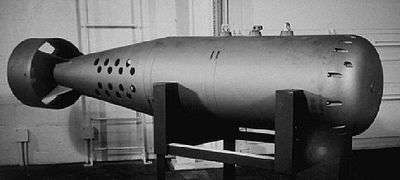Mk 101 Lulu

The Mark 101 Lulu was an airdropped nuclear depth charge developed by the U. S. Navy and the Atomic Energy Commission during the 1950s. It carried a W34 nuclear warhead, with an explosive yield of about 11 kilotons. It was deployed by the U.S. Navy for the purposes of antisubmarine warfare, in at least five different models, from 1958 through 1971. These nuclear weapons were also stockpiled overseas at the bases of NATO allies, under American military guard and control, for the potential use by maritime patrol planes of NATO. Thus was most notable at the air base of RAF St. Mawgan in Cornwall, for potential use by British Avro Shackleton patrol planes and the Royal Dutch Navy's P-2 Neptune and P-3 Orion patrol planes. Neither the Lulu nor any other kind of nuclear antisubmarine or antiship weapon was ever used in combat by any country.
The Mk-101 "Lulu" started to be replaced by the multipurpose B57 nuclear bomb during the mid-1960s. The B-57 was a bomb that could be used by tactical aircraft against land targets, as well as a nuclear depth charge.
The Mk-101 "Lulu" had a length of 7 ft 6 in (229 cm), diameter of 1 ft 6 in (46 cm), and weighed 1,200 lb (540 kg). In RAF service for carriage by Shackleton MR2 and MR3 maritime patrol bombers it was known as Bomb, AS, 1200 lb, MC.
The Lulu lacked an important safety/arming device: it had no sensors to detect the freefall from an aircraft that would follow from the depth charge's being intentionally dropped. As a result, if an armed Mk 101 bomb accidentally fell off an aircraft while it was parked on the deck of a warship, and then it rolled overboard, it would detonate at the preset depth.[1]
The W34 bomb, a boosted-fission warhead, was deployed in the Mk-101 "Lulu", and also in several other similar weapons. Also, a version of it referred to with the codename of "Peter" was used as the primary for the thermonuclear bomb in the British Yellow Sun weapons tests, and with the codename of "Python" in the American B28 H-bomb.
References
Notes
- ↑ TNA AVIA 65/2082 Proceedings of the Ordnance Board in Joint Session with the Aeroplane and Armament Experimental Establishment
Bibliography
- James N. Gibson, Nuclear Weapons of the United States: An Illustrated History (Schiffer Publishing, 1996): Chapter 12, "Nuclear Antisubmarine Weapons".
- https://web.archive.org/web/20120314120957/http://www.mcis.soton.ac.uk/Site_Files/pdf/nuclear_history/glossary.pdf